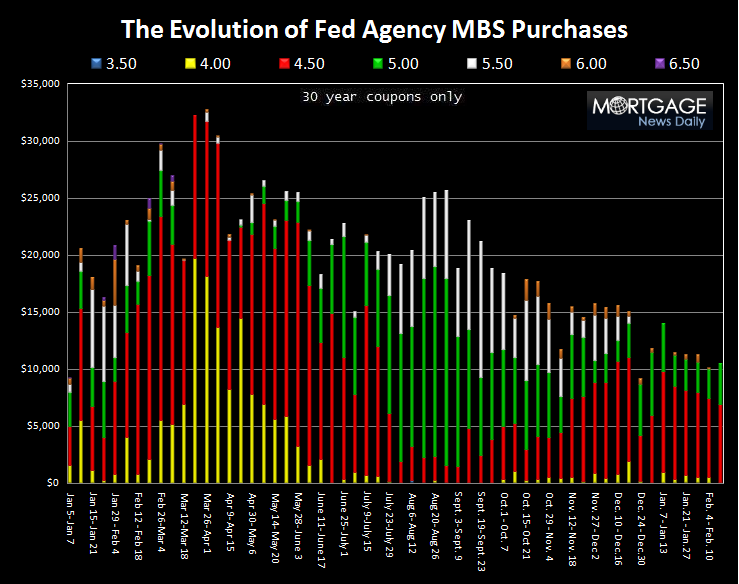Blog

Fed MBS Program Update: $55 Billion Left to Spend. Private Funding Needed
The Federal Reserve today reported on their weekly purchases of agency mortgage-backed securities (MBS).
In the week ending February 17, 2010, the Federal Reserve purchased a total of $11.3 billion agency MBS. In those four trading days the Federal Reserve sold $300 million (supported the roll market) for a net total of $11.0 billion MBS purchases.
The goal of the Federal Reserve's agency MBS program is to provide support to mortgage and housing markets and to foster improved conditions in financial markets more generally. Only fixed-rate agency MBS securities guaranteed by Fannie Mae, Freddie Mac and Ginnie Mae are eligible assets for the program. The program includes, but is not limited to, 30-year, 20-year and 15-year securities of these issuers. (NY Fed MBS FAQs)
Since the inception of the program in January 2009, the Fed has spent $1.19 trillion in the agency MBS market, or 95.59 percent of the allocated $1.25 trillion, which is scheduled to run out in March 2010. This leaves $55.08 billion left to purchase MBS coupons in the TBA market.
Of the net $11.00 billion purchases made in the week ending February 17, 2010:
- $6.85 billion was used to buy 30 year 4.5 MBS coupons. 62.27 percent of total weekly purchases
- $3.60 billion was used to buy 30 year 5.0 MBS coupons. 32.73 percent of total weekly purchases
- $425 million was used to buy 15 year 4.0 MBS coupons. 3.86 percent of total weekly purchases
- $125 million was used to buy 15 year 4.5 MBS coupons. 1.14 percent of total weekly purchases
36.1 percent of the mortgage-backs purchased were Fannie Mae MBS, 40.7 percent were Freddie Mac coupons, and 23.2 percent were Ginnie Mae. 95 percent of purchases were 30 year MBS coupons.
The Fed's daily purchase average during the holiday shortened trading week was $2.75 billion per day, which is greater than last week's daily average of $2.20 billion per day. If the Fed were to evenly disperse the remaining $55.08 billion over the next 6 weeks, they would average $1.84 billion purchases per day or $9.18 billion per week.
Given the slowdown in the mortgage market, this should be enough to offset new loan production supply from originators.
Below is a chart illustrating the evolution of the Federal Reserve's Agency MBS Purchase Program. Notice over the past few months the Fed has reduced their purchases and used remaining funds to offset new loan production supply, 4.50 (RED) and 5.00 (GREEN) MBS coupons specifically, which has helped keep mortgage rates low relative to benchmark Treasury yields. Overall, weekly purchases continue to decline, yet mortgage valuations remain stable at extremely rich levels.

We have put much energy into discussing what the mortgage market landscape will look like once the Fed exits at the end of March. Our most recent post on the topic, Fed's Exit from MBS Program on Course as Planned, goes deeper into the mortgage rates equation to explain what forces will move rates. This is a three part equation:
- The direction and movement of benchmark Treasury yields. READ MORE
- The perception of risk in holding mortgage-backed securities as an investment (loss of principal investment). READ MORE
- Supply and Demand in the agency MBS market
The last part of the equation, supply and demand in the agency MBS market, is something that has many rate watchers nervous.
In 2009, domestic and foreign banks were net buyers of agency MBS coupons. Regardless of rich valuations, we expect this trend to extend into 2010 (more buying as yield spreads widen). Hedge funds and money managers were net sellers of agency MBS in 2009. In 2010, while they will likely not be net buyers, these two market participants should balance out their exposure from an extreme sell position to a less extreme sell bias. To put it more simply, they are expected to be selling less mortgage-backs in 2010. (Think PIMCO).
Still, many doubt there will be enough demand side support to ensure mortgage rates do not skyrocket after the Fed's exit from the secondary market. Today, Ed DeMarco, Director of the FHFA, gave a speech at the “Women in Housing and FinancernPublic Policy Luncheon”. His message was quite similar to the letter hernsent to Chris Dodd, Barney Frank, Richard Selby, and Spencer Bachus (if you have not read it…its a knowledge base builder. READ IT)
DeMarco reminded us of the following:
“FHFA does not expect the Enterprises to be substantial buyers or sellers of mortgages, with an important exception, and that is the Enterprises’ purchases of delinquent mortgages out of guaranteed mortgage-backed security pools….I also expect that other private parties will begin to invest in new Enterprise mortgage-backed securities as the Federal Reserve gradually withdraws its purchase activity.”
Plain and Simple: Fannie and Freddie will not be able to demonstrate meaningul leadership when the Fed exits the MBS market. In the mortgage rates equation, it is of the highest importance that private investors step in to fill the void. Unfortunately, in order to draw in those private investors, MBS valuations will have to cheapen up relative to benchmark Treasuries…when that happens, mortgage rates will rise. (Read THIS post for more on the mortgage rates equation)
Recasting the Housing Finance Industry is a Three Step Process: Reform, Reorganize, Reassure
All Content Copyright © 2003 – 2009 Brown House Media, Inc. All Rights Reserved.nReproduction in any form without permission of MortgageNewsDaily.com is prohibited.
Latest Articles
By John Gittelsohn August 24, 2020, 4:00 AM PDT Some of the largest real estate investors are walking away from Read More...
Late-Stage Delinquencies are SurgingAug 21 2020, 11:59AM Like the report from Black Knight earlier today, the second quarter National Delinquency Survey from the Read More...
Published by the Federal Reserve Bank of San FranciscoIt was recently published by the Federal Reserve Bank of San Francisco, which is about as official as you can Read More...

Comments
Leave a Comment